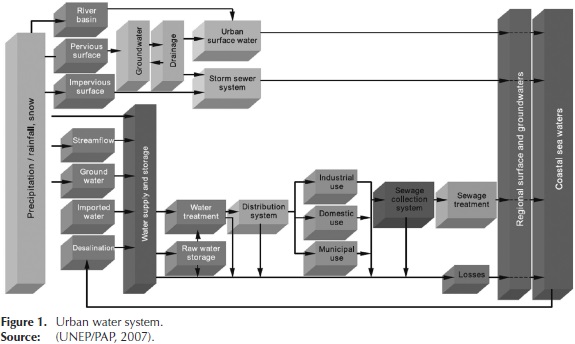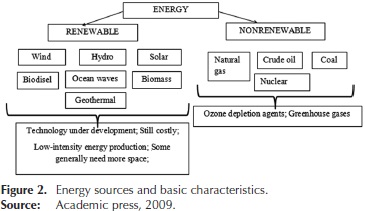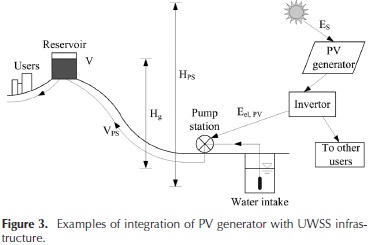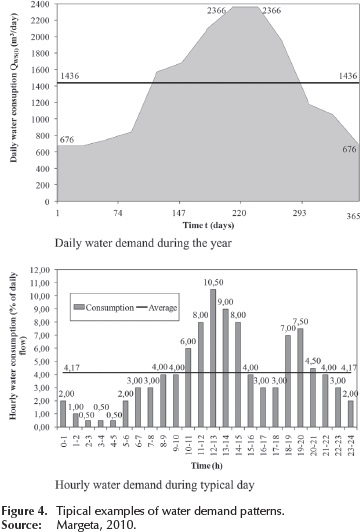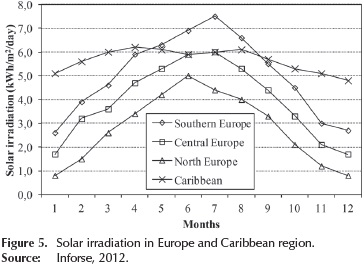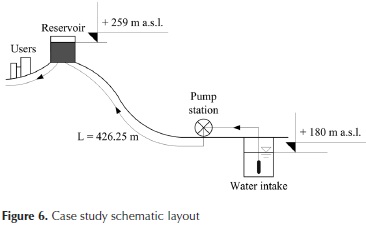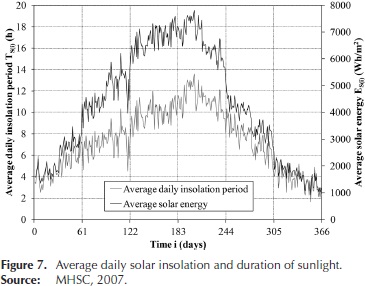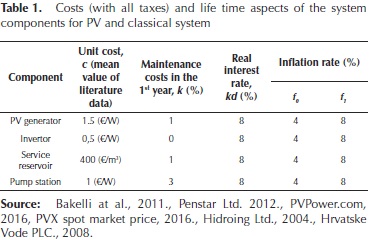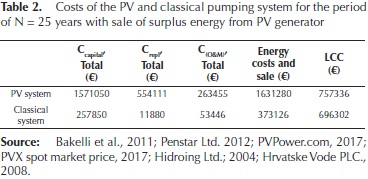Services on Demand
Journal
Article
Indicators
-
 Cited by SciELO
Cited by SciELO -
 Access statistics
Access statistics
Related links
-
 Cited by Google
Cited by Google -
 Similars in
SciELO
Similars in
SciELO -
 Similars in Google
Similars in Google
Share
Ingeniería e Investigación
Print version ISSN 0120-5609
Ing. Investig. vol.37 no.1 Bogotá Jan./Apr. 2017
https://doi.org/10.15446/ing.investig.v37n1.57983
DOI: http://dx.doi.org/10.15446/ing.investig.v37n1.57983
Innovative approach for achieving sustainable urban water supply system by using solar photovoltaic energy
Enfoque innovador para el desarrollo de un sistema sostenible de abastecimiento urbano de agua mediante la utilización de energía solar fotovoltaica
Jure Margeta1, and Bojan Durin2
1 Master of Civil Engineering, Faculty of Civil Engineering, Zagreb, Croatia Affiliation: Tenure track professor, PhD., Faculty of Architecture, Civil Engineering and Geodesy, Split, Croatia. E-mail: margeta@gradst.hr
2 Master of Geoengineering, Faculty of Geotechnical Engineering, Varazdin, Croatia. Affiliation: Assistant Professor, PhD, Faculty of Geotechnical Engineering, Varazdin, Croatia. E-mail: bojan.djurin@gfv.hr
How to cite: Margeta J., and Durin, B. (2017). Innovative approach for achieving sustainable urban water supply system by using solar photovoltaic energy. Ingeniería e Investigación, 37(1) 58-67. DOI 10.15446/ing.investig.v37n1.57983
Received: June 10 th 2016 Accepted: February 28 th 2017
ABSTRACT
This paper describes and analyses new and innovative concepts for possible integration of solar photovoltaic (PV) energy in urban water supply system (UWSS). The proposed system consists of PV generator and invertor, pump station and water reservoir. The system is sized in such a manner that every part of it is sized separately and then, integrated into a whole. This integration is desirable for several reasons; the most important is the success of the objectives of sustainable living in urban areas i.e., achieving of sustainable urban water supply system. The biggest technological challenge associated with the use of solar, wind and other intermittent renewable energy sources RES is the realization of economically and environmentally friendly electric energy storage (EES). The paper elaborates the use of water reservoires in UWSS as EES. The proposed solution is still more expensive than the traditional and, is economically acceptable today in the cases of isolated urban water system and special situations. Wider application will depend on the future trends of energy prices, construction costs of PV generators and needs for CO2 reduction by urban water infrastructure.
Keywords: Urban water supply system, sustainability, solar photovoltaic energy, CO2 reduction.
RESUMEN
Este artículo describe y analiza conceptos nuevos e innovadores para la posible integración de la energía solar fotovoltaica (PV) en los sistemas de abastecimiento urbano de agua. El sistema propuesto consiste en un generador fotovoltaico y un inversor, una estación de bombeo y un depósito de agua. El sistema se dimensiona de tal forma que cada una de sus partes se clasifica por separado y luego se integran en un todo. Dicha integración es deseable por varias razones: la más importante es el éxito de los objetivos de la vida sostenible en las zonas urbanas, esto es, el desarrollo de un sistema sostenible de abastecimiento urbano de agua. El mayor desafío tecnológico asociado con el uso de energía solar, eólica y otras fuentes de energía renovable intermitentes, es que el almacenamiento de energía eléctrica sea económico y amable con el medio ambiente. En este documento se revisa el uso de reservorios de agua en los sistemas de abastecimiento, como una forma de almacenamiento de energía eléctrica. La solución propuesta es aun más costosa que la tradicional y, hoy en día, es económicamente aceptable en los casos de sistemas aisla-dos de agua urbana y situaciones especiales. Una aplicación más amplia dependerá de las futuras tendencias de los precios de la energía, los costos de construcción de los generadores fotovoltaicos y las necesidades de reducción de CO2 por la infraestructura de agua urbana.
Palabras clave: Sistemas de abastecimiento urbano de agua, sostenibilidad, energía solar fotovoltaica, reducción de CO2.
Introduction
The world today is faced with a growing number of inhabitants who concentrate in all major cities, mostly in the coastal marine zone (Roberts, 2011 and UNEP/PAP, 2007). In an increasingly urbanized world, there is a need to plan and manage our cities in order to sustain them. It is necessary to strive for urban areas that contribute to local, regional, and global sustainable development. Naturally, this also applies to urban infrastructures and services, including Urban Water System (UWS), Figure 1. The urban water systems (UWS) i.e. water supply and sanitation, drainage and flooding prevention, pollution controls, are infrastructures which significantly reduce environmental health problems and thus contribute to the sustainability of cities and sustainable development in general.
The biggest challenge for modern urban water system operation is to keep water and wastewater flowing at affordable rate, without threatening the urban and wider natural environment. This is achieved in various ways, and one is by using renewable resources (UN, 1992). Water is a main resource of urban water supply system (UWSS) and the other key resource for the operation of UWSS is energy. Possible concepts of locally renewable energy production and consume by UWSS are a topic of this paper.
Sustainability, UWSS and renewable energy
Energy is necessary to bring water to the consumers and take wastewater from towns to water resources, or to recycle, (see Figure 1). One characteristic of UWSS is that water consumption goes hand in hand with energy consumption, since energy is required for water production, treatment and distribution, and wastewater collection and treatment. It means that utilities buy most energy at the highest price during the day. UWSS activities are energy intensive and in general, grow as the city and total water consumption grow. About 80-90 % of operation costs for water utility are directly related to the cost of water pumping (Brandt et al., 2011), since water has to be brought at a higher elevation to produce the required water pressure in the water network, which is about 4-6 bars. With the expected increase in energy prices, the share of energy costs in operation costs of UWSS will certainly grow and the question is just how much and with what impact on the sustainability of the UWS. Electric energy consumption in the UWSS depends on the characteristics of the urban environment and the UWSS and ranges from 100-200 kWh/capita/year (EPRI & WRF, 2013). This means that the UWSS is a significant source of CO2 emissions as a result of the use of electric energy from fossil fuels.
In addition to energy efficiency measures, the reduction in energy costs is generally achieved by shifting energy consumption as much as possible to off-peak periods (cheaper energy), and by the use of renewable energy. So, sustainabilty can be improved by development renewable "locally produced and consumed energy".
Energy production from wind and solar power, small hydroelectric plants, biomass and geothermal is considered green power (see Figure 2). Renewable energy is an unending source of energy that quickly replenishes itself. These sources of energy do not cause pollution or release toxics substances. However, renewable energy sources are low-intensity energy, so in order to convert them into useful energy the collection needs to be distributed over large areas. It should be stressed that renewable energy is subset to sustainable energy.
This raises the question of whether and which RES may be eligible and how they should be used by the UWSS, as stand-alone energy production system for different users of UWSS (i.e. for pump stations), or by connection with the energy grid network, local or/and regional. The current technological development and use of RES is not yet a complete and productive alternative to conventional energy sources. The problem is that the most important RES sources, such as solar and wind energy, so called intermittent RES (RES-I), cannot be directed toward energy consumption and remain stable and controllable sources, such as hydro, geothermal, biomass and others, so called constant (RES-C) (Glasnović & Margeta, 2011). Solar and wind energy are not constant, since wind generators produce energy only when an appropriate wind is blowing and solar generators only during the sunlight period. Therefore, these RES-I cannot produce energy continuously and supply a consumer, so it is necessary to hybridize them with conventional sources through the electric energy grid system or the use of Electric Energy Storage (EES).
In this way, EES has the most significant role in realization of green energy supply to UWSS. Numerous technologies of energy storage are known today (batteries, flywheel, pressure vessels, etc.), which differ in: size, energy storage costs, efficiency, lifetime, costs per cycle, etc., (Chen et al., 2009). It is well known that none of the present-day technologies could, in terms of ratings, be compared to storage by pumped storage hydroelectric plant (PSH), (ESA, 2009). Precisely because of that, PSH is today still the most significant EES, which is a mature technology with large volume, long storage period, high efficiency and reliability, while capital cost per unit of energy is low, (Dunn et al., 2011).
Obviously the most reliable solution for UWSS is the use of green energy from green energy power system/network. Such energy systems still do not exist and this is for UWSS a long term solution for the time when such green energy network will be available. Naturally, the question is whether there is a local solution to the use of green energy (stand alone system) that would satisfy the rigorous criteria related to the reliability of the UWSS and contribute to the achievement of sustainability goals. This should be a solution that would use locally available RES and its own infrastructure system as energy storage, and if possible as energy resource. So, to intermittent RES, wind and solar sources RES-I, could be used with hydro, biomass and other stable RES-C, if available within or close to the urban area. Such solution obviously requires reliable and economically affordable solution of energy storage and network; A possible solution is presented in this paper.
Integration of RES with UWSS
The RES-I that, due to their global distribution, can be widely used in the UWSS are wind and solar energy. Wind is a global and local energy source, available at numerous locations with different energy potential. Wind energy derives from winds which are generated by Sun energy. Wind development project starts with the analysis of a windy site, since the economics of wind power depends strictly on wind velocity and duration during the year. The actual energy contained in the wind varies with the third power of wind speed (EWEA, 2009). One thing is certain: there is no wind location close to the UWSS that is sufficiently reliable and blows at adequate speed throughout the whole year and so from year to year. Interruptions of production are therefore, possible and their characteristic is high unpredictability of occurrence and duration. This characteristic of wind turbines is actually the biggest problem for the off-the-gride energy source for UWSS. On the other hand, more or less solar energy is mostly available every day and the Sun as the source of energy for energy generation is more reliable than the wind. This energy is free and it is available at each location where people live. In principle, solar power can be generated anywhere on Earth, but with different productivity; the brighter the sunlight, the higher the output and better economic characteristics of the power generator. Obviously, a promising solution for sustainable energy supply can be by the use of solar energy.
Two types of solar generators in use are solar photovoltaic (PV) plants and solar thermal (ST) plants. PV plants turn sunlight directly into electric energy. They are very simple plants, but based on innovative technology which is energy intensive. ST plants use the sun simply as the source of heat. The heat is captured, concentrated and used to drive heat engines and electricity generators. They are complex plants mostly based on the existing power station technology. They can generate electricity only when the Sun is shining. During the night there is no sun and electricity, which is the major weakness of the plants. To be able to produce continuous power out of grid users they require some kind of classical fuel back-up or incorporate electric energy storage. It is important to emphasize that the "free solar energy" is available in the period when the energy from the regional energy system is the most expensive (generally from 6 to 18 hour) and the savings on energy costs are the greatest. Also, the annual production of energy in some areas coincides with the annual increase in water consumption (for example Mediterranean tourist areas).
The RES-C that could have their application in the UWSS is geothermal, biomass, and small hydro-electric plants. These are site specific sources of energy, and technologically very different. Geothermal energy is obtained from the Earth's internal heat and can be used for generating steam to run steam turbines and electricity generators. A prerequisite for the installation of this energy source is the existence of favourable geothermal conditions near or in the cities. Biomass includes any organic matter that is available on renewable or recurring basis. Biomass energy can be derived from gaseous, solid or liquid biomass. As it is renewable and abundant, biomass has the potential to offer diverse supply of reliable, affordable and environmentally sound chemicals and energy to replace fossil fuels. Biomass includes energy crops and trees, agriculture crop residuals, animal manures and other organic waste materials, as well as sludge from wastewater treatment plants. Biomass energy (gaseous biomass) has long been used at the wastewater treatment plants but not in UWSS. Energy source is methane gas (bio-methane) generated from the energy stored in sludge, by the process of anaerobic digestion of the sludge. Advanced fluidized bed technology also has been used for treatment sludge producing electric energy and heat. It is a proven technology as well as its economy. Unfortunately, avaiable energy is not sufficient to satisfy all needs of UWSS. Hydro-electric energy is a classic and economically advantageous source of green energy and power, but is often unavailable locally or in the cities. It doesn't produce significant greenhouse gasses. However, it may have other environmental impacts related to storage construction, but small plants or plants without small storages have insignificant environmental impacts. The UWSS itself is a potential source of hydro energy which is traditionally used, if available. Mostly it is the available potential energy on an aqueduct system, available for small power plant development. The water will be used in the same proportion as it is available in the pipes. Such system is known as a run-of-rive plant with flow turbine which can be put directly into pipe (ESHA, 2010; Kucukaly, 2011). Such solution doesn't have a negative impact on the environment, does not require additional water resources and reduces pressure in the network and so water losses. However, hydroelectric energy can also be generated by the so-called concept of solar hydroelectric plant (Margeta and Glasnović 2010). Also, this solution doesn't have negative effects on the environment and does not require additional water resources and is therefore very acceptable in view of the environment. When all the above said is summarized, it can be concluded that the most promising external source of RES energy for UWSS is solar energy and especially PV technology while the internal source of energy is biomass and hydro. Biomass and hydro energy are traditionally used, and there is no need for further elaboration (US Army Corps of Engineers, 1985 and Qasim, 1994). Unfortunately, the available amount of this energy usually cannot satisfy the largest consumer of energy within UWSS. Therefore, as the most promising long-term solution that is applicable everywhere with unlimited capacity is most likely solar energy and will therefore be elaborated in this paper in more detail. We believe that the sun energy is the most acceptable primary source of energy for the urban water system. Photovoltaics, which directly convert solar energy into electricity, offer a practical and sustainable solution to the challenge of meeting the increasing global energy demand. It is renewable locally produced and consumed energy of any power. The Sun continuously provides the Earth with a huge amount of energy, equally distributed all over the world. It is clean, abundant, and a more and more economical energy source. Since 1980, the cost of silicon modules, the finished packages of cells that are put in service, has fallen by 90 %%. The installation of solar capacity is now in some countries on par with that of building conventional power plant.
The concepts of integration of solar photovoltaic energy and UWSS
Solar photovoltaic water pumping system
A prerequisite for the use of solar energy is the implementation of electric energy storage. If some of the operating EES (mechanical, electrical, chemical and electrochemical) can't be used because they are expensive and of unacceptable features for work in green UWSS (pollution free operation, high round-trip efficiency, flexible power, long cycle life and low maintenance), the only solution is the internal integration of solar energy with UWSS on a such a way that will eliminate use of such EES (batteries). Internal integration with UWSS refers to the use of UWSS water reservoires as EES. This is a somewhat innovative concept that is elaborated in this paper. The solution for the use of intermittent RES is related to the use of the water storages in the UWSS system, which essentially acts as energy storages. In the water supply systems, storages are accumulations or reservoirs of raw water and service reservoirs in the water supply distribution system.
The concept of using solar energy and resorvoirs/storages is conceptually simple, Figure 3. It is the concept for water pumping into storage: for example, in the case of water service reservoirs water is pumped into service reservoirs in the period when solar energy is available. Water for reserovoir is used continuously in the system in accordance with needs.
The capacity of EES or volume of reservoir is determined by inflow and outflow time series or inlet and outlet environment characteristics. The system state equation (balance equation) can be expressed as follows:
where increment t assumes the values t = 1 to N (N is the total number of time stages, e.g. days or hours); V(t-1) and V are storage volumes in (t-1) and t period respectively (m3/t); VPS(t) is water pumped by the PV power plant in period t (m3/t); VOUT(t) is water discharged from the storage/reservoir into the water supply system and Vloss(t) are water losses from storage in t period (m3/t). The system state equation includes the most important variables of the water balance. This is an example of water pumping into service reservoir of the water supply system.The pumping system has constraints; the most important being the capacity of inlet environment/water supply intake capacity (suction capacity). If the capacity is greater than the maximum hourly pumping when insolation is maximum, there are no constraints. In all other situations, if we want to take advantage of all daily solar energy available at the moment, the suction tank should be applied to suction environment, if possible, regulating its water capacity. Urban water supply service reservoir is closed and waterproof, variable Vloss(t) is 0 for all practical purposes. Water discharge VOUT(t) is the urban hourly water demand during the day and is generally known and prescribed in the process of the water supply system design, Figure. 4. That is why these variables in the designing process can be considered as determining values. Water variation (VOUT(t) depend on the size of the settlement and activities there. Therefore, in the settlements with seasonal tourism, as is the case of coastal settlements in the Mediterranean, seasonal variations of water consumption are typical, where maximum daily consumption in the summer is up to 10 times higher than in the winter, which coincides well with the increasing solar irradiation in this period. This is a very favourable condition since it reduces significant increase of PV generator capacity as result of water consumption needs.
Water pumped by the PV power plant VPS(t) is the result of available solar energy and therefore is changeable as the solar energy irradiation, Figure 5.
Daily insolation varies considerably from day to day, depending on weather conditions (cloudiness) on the day in question. However, the general trend of changes is stable throughout the year (mean monthly values) and in accordance with the climatic features of the area, Figure 5. Also, the pattern of sun irradiation is generally very stable during the day. It can be disrupted depending on daily cloudiness.
In the proposed concept the PV power plant receives free energy from the Sun. This energy is converted into work (mechanical energy) of the pump, which increases the internal energy of fluid or water volume at the particular elevation needed. In this way, without applying heat, the work has done on fluid through the pump raises the internal energy of the fluid from the lower to the upper water level or from water intake to reservoir. Part of the energy is lost in this process. Losses are associated with mass flow, work interaction and heat interaction. Losses are the highest in the PV generator, and refer to the conversion of solar to electric energy (about 87 %; Koroneos et al., 2003) while the losses are significantly lower in the pump system (1015 %; Margeta, 2011) and mostly relate to losses in friction due to fluid movement through pipes and equipment. Water in the reservoir/chamber is the available potential energy for water flow.
For a given nominal power Pel,PV (kW), possible pumping volume of water VPS(t) (m3) in time period t into the reservoir is (Margeta and Glasnović 2010):
Where HPS(t) (m) is total head, VPS(t) (m3) is water volume to be pumped by PV generator in time stage t (m3); ηPV is average efficiency of the PV generator, ηMPI is average efficiency of motor-pump unit and inverter; ES(t) (kWh/m2) is average daily solar energy available for energy production, all in time step t. The cell area APV (m2) of PV collectors can be calculated by (Kenna & Gillett, 1985):
Since the solar irradiation is mostly more or less available each day for about 12 hours, the realization of this concept for pumping water into the water supply system is feasible and inexpensive. Water is pumped in the period when consumption is the highest, so in principle, it does not increase the volume of the service reservoir. During the day all amounts that are consumed during the night should also be pumped and they are significantly less than the daily amount. In any case, the service reservoir volume should be smaller than in the case when water is pumped only at night due to the use of cheaper energy. Spare space can be provided in the reservoir for the case of disruptions in energy and water supply. The solution must have the required level of safety in accordance with the features of solar irradiation in the design/planning period, one or several critical years, which can be achieved with appropriate selection of the PV generator power and service reservoir volume.
It should also be kept in mind that if PV generators for the UWSS are built in order to cover the needs of the most critical day of the planning period, in the other periods of the year they generate significant surpluses of electric energy according to the increase of solar irradiation. Therefore, there is no need to built new PV generators, but a local energy transmission network should be built, or if possible, arrange the exchange of energy with the regional energy power system (EPS), and thus avoid building its own local network. Many variants can be derived with one or two storages, different energy networks and exchange arrangements, as well as system objectives functions. The proposed concept can essentially be applied on the main water aqueduct (equally on raw and drinking water), as well as in the water supply network.
Sizing methodology
At the beginning of the analysis, it is necessary to define the daily quantity of water in the settlement VWS(i), according to settlement characteristics and water consumption regime throughout the year of the planning period (i = 1,..., 366 days). After this the daily water usage pattern in a settlement QWS(t) (t = 1,...,24 h) is determined.
The PV generator power pel(i) is calculated for every day in the year and the potential annual production of electrical energy is generated in accordance with the climate characteristics of the area. Based on the obtained values, the minimum required size of the PV generator pel,PV is determined, which provides the necessary inflow of water in the critical period. This procedure is simple, because the relation between Pel,PV and VPS is linear. Based on the selected/calculated initial value Pel,PV and VPS, which satisfy the demand, the minimum required power is determined from the established differences:
Due to that, critical day/period for sizing of the PV generator is ttb,i,PV is determined by the minimum daily difference:
where ΔVi is acceptable difference in practice application.
The selected power of the PV generator Pel,PV will satisfy the demand throughout the whole planning period, whereby it will generate excess electric energy in the greater period of the year. Surplus electricity can be used locally in the water supply system or transmitted into the regional power system and thus realize significant profits because significant incentives are given to the production of green energy in many countries. This energy can pay the costs of energy consumed from the regional power system in incidental situations (failure, insufficient sunshine, etc.).
The size of service reservoir has been calculated for each day in the year, i, in accordance with each balancing period tb in the year, by using of equation (1). In general, the critical day/period for the design of volume reservoir ttb,i,V is the day with maximum water demand Vdaily, providing that on day available insolation ES(i) is sufficiently high:
The next step selects the capacity QPS and power pPS of the pumping station. Procedure for finding of the critical day ttb,i,PS for the design of pump station is the almost similar as is for the volume reservoir, but in this case it is necessary to include usable duration of insolation TS :
Since insolation is variable during the year and during the day, the pumping station work is variable both in terms of the required capacity, as well as in relation to the period of operation. Therefore, it is necessary to provide an energy efficient solution for different operating regimes that may occur during the year, as well as adequate reserve capacity.
The size of the system structures, and thus the cost of building the system, significantly depends on the regime of sunshine and water demand during the year. There are different situations depending on the climatic characteristics of the area and activities, i.e. demand in water supply system. However, the concept is very flexible and reliable, especially in cities where water consumption is greatly affected by climatic characteristics of the area, such as tourist areas of the Mediterranean. In these areas, especially in small tourist towns, the dynamics of solar radiation coincides with the dynamics of water consumption during the year. Summer insolation is higher, but water consumption is also higher in towns due to seasonal tourism.
The proposed sizing methodology of the PV system is based on critical insolation (which is usually in the winter), gives a surplus of power in the remaining period of the year, which is a certain reserve in the PV generator power during periods of high demand in the summer. This means that in the case of smaller daily insolation, due to cloudiness, the system is capable of pumping the required water quantities. On the other hand, large reservoir volume designated for the critical period of water supply (summer period with the highest consumption of water) is a good reserve of the available water volume for possibly lower insolation in the winter when demand is many times smaller, and insulation is significantly weaker and more uncertain due to the higher cloudiness. This means that if the backup of water in the reservoir is maintained, it can meet the water demand in a period of several days when insolation is possibly lower than calculated.
The total head of the pumping station HPS is variable, i.e. the highest when demand is the greatest. This means that in other periods the pumping station has a significant surplus of capacity. The capacity of the pumping station in this case is still significantly higher than in the case of the use of energy from regional grid system. The same goes for the reservoir volume because water is pumped within 24 hours. Therefore, designing a green solution for water pumping in the water supply system has a large reserve for incidental situations. Normally, it is always possible to use the energy from the grid system or other local source of energy.
Case study
This case study presents a hypothetical example of a settlement located on an island, which is located in the southern Mediterranean part of Croatia. The positions of the basic facilities of the water supply system are shown in Figure 6. Analysis will be done only for balancing period of one day (tb = 1 day), due to scope and purpose of this work.
In order to assess differences, the main pumping system has been designed with PV generator application and by classical approach with 24 h constant pumping with energy use from grid system. Figure 4 shows yearly and daily water consumption profile. Total head of the pump station is HPS=82,41 m. For this case, the average efficiencies for the inverter and motor pump unit are ηPSI = 0,75, for the pump station ηpS=0,9, for the inverter ηPS = 0,9 and for the PV system ηPV = 0,15. The average daily global radiation ES(i) and average daily insolation period TS(i) is shown in Figure 7.
The PV generator application with power of 512,5 kW increase required reservoir volume in relation to the classical solution with 24 hour pumping water into the reservoir about 100 %>, i.e. volume increases from 584 m3 to 1100 m3. The increase of the required capacity and power of the pumping station is even more significant - about 400 °% because all the water is pumped only during insolation, with 27 l/s up to 118 l/s, respectively with 24,25 kW up to 106,05 kW. The increase is significant, and it could be said that the cost of building the water infrastructure has a major impact on construction costs. Other, far more significant investment cost is building PV generator which makes up about 60 °% of the total investment. The greatest economic benefit in relation to the classical solution is operation costs, as the proposed concept has no energy costs. In addition, during the year PV generator produces excess energy that can be placed on the market and thus make a profit.
The concept of life cycle cost, LCC (€) (Bakelli et al., 2011 and Ghoneim, 2006) and netto present value (Markvart and Castaner, 2003 and Stevanović and Pucar, 2012), is used for the system cost analysis. LCC takes into account the initial capital cost (Ccapital), the present value of replacement cost (Creplacement) and the present value of operation and maintenance cost (Coperation&maintenance). LCC also includes energy sale profit for PV system and energy costs for classical system (Tables 1. and 2.), Lifetime of the PV generator is 25 years, of the invertor 10, of the service reservoir 25 years and for the pump station 15 years.
The present costs of implementation of the PV concept are little higher than the classical solution by approximately 8 °%, where the adopted nominal discount rate for PV electric energy is 10 °% (U.S. Department of Energy, 2010) and for classical electric energy is 8 °% (Friedrich & Eldridge, 2009). In different climate conditions and with different water needs, the economic indicators would be different so that it is difficult to generalize. It is hard to say whether and when the proposed concept will be cheaper than the conventional one in the future, because it mostly depends on the price increase trend of conventional energy and cost reduction trend of building the PV generator. The trend is such that it certainly goes in favour of the PV system. Roughly, the current costs of silicon-based solar cells, with all taxes, are US$ 1,5 per Watt, and the trend is downward. The price of the PV generator has declined from 1980 by 90 % and continues to decline about 4 % to 7 % per year (PVPower. com, 2017; PVX spot market Price, 2017). In the last decade, solar has experienced a compound annual growth rate of more than 60 %% (SEIA, 2017). Also, the efficiency of the PV generator is increasing from the currently commercially between 16 and 25 %% (Green et al, 2016, IEA, 2016), with the expected incresing trend up to 46 %, which has already been laboratory made (NREL, 2016). Therefore, the application of PV generator will be easier (less space will be need) and cheaper. The price of electric energy from the regional energy supply system gradually increases with the increase of costs of oil and other fossil fuels and the costs of the energy system operation (Kerr, 2012). The growth will continue in the future, by approximately 2 % per year within
Using of PV energy helps in reducing of greenhouse gas emissions and thus climate changes. This means that using of the shown concept is one of the solutions in achieving of the obligations which arise from Paris Agreement (UN, 2015). In the analyzed case, if it is assumed that all electric energy is produced in a coal-fired power plant, which typically emits 0,95 kg of CO2/kWh (Margeta & Glasnović 2011), then the amount of the CO2 emission that will not be released into the atmosphere is yearly 1325 t, i.e. 1 kg of CO2 per m3 the pumped water.
Discussion and conclusions
It has been shown the proposed concepts for local energy production and use are feasible and sustainable. Variables pel,PV and V are a conjugated pair of the system. In that way, the storage also acts as an energy storage, and because of that the size of the storage significantly influences the size/power of the plant pel,PV and vice versa. Larger storage requires smaller PV power plants for the same water demand in the design period (one or several days).
Simply put, if the available reservoir volume is sufficient to store the water needed to supply the population/consumers in the period when there is no insolation, the technological conditions linked to the EES are met. It also means that the water intake and pumping station have sufficient capacity to meet the water needs in the insolation period (during the day) when all the required quantity of water for the daily and nightly water supply demands must be pumped into the reservoir. As has already been explained, water pumping and demand pattern in the calculation period (critical year) of the system sizing will determine the appropriate size of the reservoir, pump station and PV generator.
In conclusion, it can be said that the proposed concept already has its application in certain situations and that in the future the conditions for the application will be even more favourable. This is particularly true for the existing water supply system with excess capacity of service reservoir and pump station so that the investment applies only to PV generator. However, the most important conclusion is that the proposed concept can be a reliable substitute for conventional electric energy supply and that it is locally sustainable.
This concept has already justified its use in all situations where it is not possible to use electric energy from the regional energy system or when the use is unreliable and erratic because of poor condition or lack of capacity of the power system. These are water supply systems on isolated islands or locations significantly distant from the electricw supply grid and conventional power plants.
The proposed concept can also be used as a form of back-up system which during periods of daily insolation works and covers peak energy consumption in the system (the most expensive energy) and also serves as a partial supply of energy if there is an interruption of power supply from the power grid. The optimal capacity of PV generator and other infrastructure should be determined by implementation of a comprehensive analysis of the concrete issue. Energetic support to classical energy supply can also have seasonal character, when due to summer tourism the water consumption increases, but at the same time, because of the higher summer insolation (which is the usual reason for tourism), the solar energy production increases (Mediterranean area). Therefore, it is possible to provide local energy production and thus increase safety and possibly the efficiency of energy supply, without increasing the capacity of energy supply lines for energy needs during the short tourist season (3-5 months). During the out of season period the PV generator serves as a complete or backup power supply system. In this case there is no increase in the capacity of water infrastructure (pump station and reservoir) as they are sized to summer peaks in water consumption that are 5 - 10 times higher than winter consumption.
Normally, all possibilities of applying the proposed concept have not been exhausted. It is now up to engineers and researchers to research and study and upgrades the proposed concept and its possible application. This kind of investment could change the urban water system and provide generations to come with a brighter future.
References
Academic Press. (2009). Renewable Energy Focus Handbook. San Diego, USA: Elsevier Inc. [ Links ]
Bakelli, Y., Hadj, A. A., Azoui, B. (2011). Optimal sizing of photovoltaic pumping system with water tank storage using LPSP concept. Solar Energy, 85(2), 288-294. [ Links ]
Brandt, M., Middleton, R., Wheale, G., Frans Schulting, F. (2011). Energy efficiency in the water industry, a global research project. Water practice & Technology, 6(2), 1-15. [ Links ]
Chen, H., Cong, T.N., Yang, W., Tan, C., Li, Y., Ding, Y. (2009). Progress in electrical energy storage system: A critical review. Progress in Natural Science, 19(3), 291-312. [ Links ]
Dincer, I. (2000). Renewable energy and sustainable development: a crucial review. Renewable and Sustainable Energy Review, 4(2), 157-175. [ Links ]
Don, J., Kannan, N. (2009). Smart and micro grid model for renewable energy based power system. Engineering modelling, 22(1-4), 89-94. [ Links ]
Dunn, B., Kamath, H., Tarascon, J.M. (2011). Electrical energy storage for the grid: a battery of choices. Science, 334(6058), 928-935. [ Links ]
Electric Power Research Institute (EPRI) & Water Research Foundation (WRF). (2013). Electricity Use and Management in the Municipal Water Supply and Wastewater ¡n-dustries. Palo Alto, USA: Electric Power Research Institute. [ Links ]
ESA-Electricity Storage Association. (2009). Storage technologies, Technology Comparisons tonline). Retrieved from: http://www.electricitystorage.org/technology/storage_technologies/technology_comparison.,(accessed May 2013). [ Links ]
ESHA-European Small Hydropower Association. (2010). Energy Recovery in Existing Infrastructure with Small Hydro-power plants: Multipurpose Schemes-Overview and Examples. Brussels, Belgium: ESHA. [ Links ]
EWEA. (2009). The Economics of Wind Energy. Brussels, Belgium: EWEA. [ Links ]
FEMP. (2014). FEMp Commercial Electricity Cost Escalation Rates for 25-Year Analysis for 2013. Washington, USA: FEMP [ Links ]
Friedrich, K. & Eldridge, M. (2009). Saving Energy Cost-Effectively: A National Review of the Cost of Energy Saved through Utility-Sector Energy Efficiency programs. Washington, USA: American Council for an Energy-Efficient Economy. [ Links ]
Ghoneim, A. A. (2006). Design optimization of photovoltaic powered water pumping system. Energy Conversion and Management, 47(11-12), 1449-1463. [ Links ]
Glasnović, Z., Margeta, J. (2011). Vision of total renewable electricity scenario. Renewable and Sustainable Energy Reviews, 15(4) 1873-1884. [ Links ]
Green, M. A., Emery K., Hishikawa Y., Warta W., Dunlop E. D., (2016). Solar cell efficiency tables (version 47). Progress in photovoltaics, 24(7), 905-913. [ Links ]
Hidroing Ltd. (2004). The Regional Water Supply System: Neretva, peljesac, Korcula, Lastovo, Mljet - Novelation of pre-investment programe. Split, Croatia: Hidroing Ltd. (In Croatian). [ Links ]
Hrvatske Vode PLC. (2008). Water Supply plan of Split and Dalmatia County. Hrvatske Vode PLC: Split, Croatia. (In Croatian). [ Links ]
International Energy Agency (IEA) (2016). PVPS trends 2016 in photovoltaic applications. St. Urse, Switzerland: IEA. [ Links ]
Inforse-International Network for Sustainable Energy, (2012). Solar energy. Retrieved from http://www.inforse.org/europe/dieret/Solar/solar.html, (accessed May 2013). [ Links ]
Kenna, J., Gillett, B. (1985). Solar Water pumping: A Handbook.. London, United Kingdom: ITDG Publishing. [ Links ]
Intermediate Technology Publications, Kerr, A.R. (2012). An oil gusher in the offing, but will it be enough?. Science, 338(6111), 1139. [ Links ]
Koroneos, K., Spachos, T., Moussiopoulos, N. (2003). Energy analysis of renewable energy sources. Renewable Energy, 28(2), 295-310. [ Links ]
Kucukaly, S. (2011). Water supply lines as a source of small hydropower in Turkey: A Case study in Edremit. World Renewable Energy Congress, Linkoping, Sweden. [ Links ]
Leitmann, J. (1999). Sustaining cities: Environmental planning and Management in Urban Design. McGraw-Hill. [ Links ]
Margeta J. (2011). Water Supply: planning, design, management and water purification. Split, Croatia: Faculty of Civil Engineering and Architecture, University of Split, Split, Croatia. (in Croatian). [ Links ]
Margeta, J. (2010). Water Supply: Planning, Design, Management and Water Purification. Split, Croatia: Faculty of Civil Engineering and Architecture, University of Split, Split, Croatia. (in Croatian). [ Links ]
Margeta, J., Glasnović, Z. (2010). Feasibility of the green energy production by hybrid solar + hydropower system in Europe and similar climate areas. Renewable and Sustainable Energy Reviews, 14(6), 1580-1590. [ Links ]
Margeta, J., Glasnović, Z. (2011). Exploitation of temporary water flow by hybrid PV-hydroelectric plant. Renewable Energy, 36(8), 2268-2277. [ Links ]
Markvart T., Castaner L. (2003). Practical Handbook of Photo-voltaics: Fundamentals and Applications. London, United Kingdom: Elsevier. [ Links ]
Penstar Ltd. (2012). Price Book. Penstar Ltd.: Cardigan, UK. [ Links ]
PVPower.com, Chicago, USA. (2017). Retrieved from: http://www.pvpower.com/howefficientissolarenergy.html, [Accessed February 2017] [ Links ].
PVX spot market price - index solar PV modules (2017). Cologne, Germany. Retrieved from http://www.pvxchange.com [Accessed February 2017] [ Links ].
Qasim, S.R. (1994). Wastewater treatment plants; planning, Design and Operation. Basel, Switzerland: Technomics publishing Co. Inc. [ Links ]
Roberts, L. (2011). 9 Billion?. Science, 333(6042), 540-543. [ Links ]
SEIA - Solar Energy Industry Associates. (2017). Retrieved from http://www.seia.org/research-resources/solar-industry-data, [Accessed February 2017] [ Links ].
Stevanović, S., Pucar, M. (2012). Investment appraisal of a small, grid-connected photovoltaic plant under the Serbian feed-in tariff framework, Renewable and Sustainable Energy Reviews, 16(3), 1673-1682. [ Links ]
U.S. Department of Energy, (2010.): The Prospect for $1/Watt Electricity from Solar. $1/W Workshop, Washington, USA: U.S. Department of Energy. [ Links ]
United Nations (UN). (1992). The United Nations Conference on Environment and Development. The Rio Declaration on Environment and Development, Rio de Janeiro, Brazil: UN [ Links ]
United Nations (UN). (2015). The United Nations Climate Change Conference. COP 21, Paris Agreement, Paris, France: UN [ Links ]
UNEP/PAP. (2007). Integrated Coastal Urban Water System Planning in Coastal Areas of the Mediterranean, Priority Actions Programme, Split, Croatia: UNEP/PAP. [ Links ]
U.S. Army Corps of Engineers. (1985). Engineering and design-hydropower. Washington, USA: U.S. Army Corps of Engineers. [ Links ]













